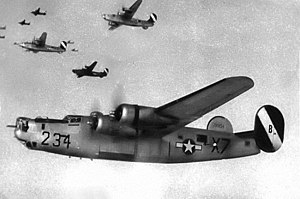RAF Rackheath: Difference between revisions
added aerial photo |
added B-24 photos |
||
| Line 1: | Line 1: | ||
[[Image:Rackheathairfield 9july1946.jpg|thumb|300px|Aerial Photo of Rackheath Airfield - 9 July 1946.]] |
[[Image:Rackheathairfield 9july1946.jpg|thumb|300px|Aerial Photo of Rackheath Airfield - 9 July 1946.]] |
||
[[Image:467bg-b241.jpg|thumb|300px|Consolidated B-24J-65-CF Liberator Serial 44-10600 of the 788th Bomb Squadron]] |
|||
[[Image:467bg-b242.jpg|thumb|300px|Ford B-24H-25-FO Liberator Serial 42-95234 "Weiser Witch" of the 788th Bomb Squadron. This aircraft crash landed at [[RAF Bungay]] on [[5 May]] 1945 after fire in the nose.]] |
|||
'''RAF Rackheath''' is a former [[World War II]] airfield in [[England]]. The field is located 5 miles NE of [[Norwich]] in [[Norfolk]]. |
'''RAF Rackheath''' is a former [[World War II]] airfield in [[England]]. The field is located 5 miles NE of [[Norwich]] in [[Norfolk]]. |
||
| Line 51: | Line 53: | ||
[[Category:Defunct World War II USAAF Fields]] |
[[Category:Defunct World War II USAAF Fields]] |
||
{{USAF-stub}} |
|||
Revision as of 22:24, 4 October 2006


RAF Rackheath is a former World War II airfield in England. The field is located 5 miles NE of Norwich in Norfolk.
USAAF Use
Rackheath was given USAAF designation Station 138.
467th Bombardment Group (Heavy)
The airfield was opened on 11 March 1944 and was used by the United States Army Air Force Eighth Air Force 467th Bombardment Group (Heavy), arriving from Wendover AAF Utah. The 467th was assigned to the 96th Combat Bombardment Wing, and the group tail code was a "Circle-P". It's operational squadrons were:
- 788th Bomb Squadron (X7)
- 789th Bomb Squadron (6A)
- 780th Bomb Squadron (Q2)
- 781th Bomb Squadron (4Z)
The group flew the B-24 Liberator as part of the Eighth Air Force's strategic bombing campaign.
The 467th began operations on 10 April 1944 with an attack on an airfield at Bourges. In combat, the unit served chiefly as a strategic bombardment organization, attacking the harbor at Kiel, chemical plants at Bonn, textile factories at Stuttgart, power plants at Hamm, steel works at Osnabruck, the aircraft industry at Brunswick, and other objectives.
In addition to strategic operations, engaged occasionally in support and interdictory missions. Bombed shore installations and bridges near Cherbourg on D-Day, 6 June 1944. Struck enemy troop and supply concentrations near Montreuil on 25 July 1944 to assist the Allied drive across France. Hauled gasoline to France in September for mechanized forces. Attacked German communications and fortifications during the Battle of the Bulge, Dec 1944-Jan 1945. Hit enemy transportation to assist the Allied assault across the Rhine in March 1945.
The group flew its last combat mission on 25 April. Returned to Sioux Falls AAF South Dakota during June and July 1945. The 467th was redesignated as the 467th Bombardment Group (Very Heavy) in August and re-equipped with B-29 Superfortresses in preperation for the invasion of Japan. With the end of the war in September, the group was assigned to Strategic Air Command on 21 March 1946. The 467th was deactivated on 4 August 1946.
Postwar Use
After the war, the field was closed in 1945 and the airfield site returned to farming. Very little of the runways, perimeter track, or hardstands remain. Most of the concrete has been broken up for aggrigate.
The technical site has become the Rackheath Industrial Estate with several of the wartime buildings being modified or extended, and used for light industry. One of the access roads on the estate has been named Wendover Road to commemorate the airbase in the US where the 467th Bomb Group was formed.
The control tower is in reasonable condition although its external appearance does somewhat give a view of dilapidation. Tentative plans are in hand to restore the tower to its original condition by the new owners and use it as an administrative building. The T-2 hangar nearby is virtually beyond recognition as to how it looked in 1943. Brickwork has been added to the front and the whole building has been repainted cream and green. Inside the building the roof girders appear to be original and identical to those seen on photographs taken in 1944. The other hangar on the eastern side of the airfield was dismantled many years ago.
A memorial to the 467th Bomb Group consisting of a plaque and a bench was dedicated in 1983, and is situated near the village sign (featuring a B-24) on the Salhouse Road, adjacent to Holy Trinity Church.
See also
References
- Freeman, Roger A., Airfields Of The Eighth, Then And Now, 1978
- www.controltowers.co.uk Rackheath
- Rackheath at http://mighty8thaf.preller.us
